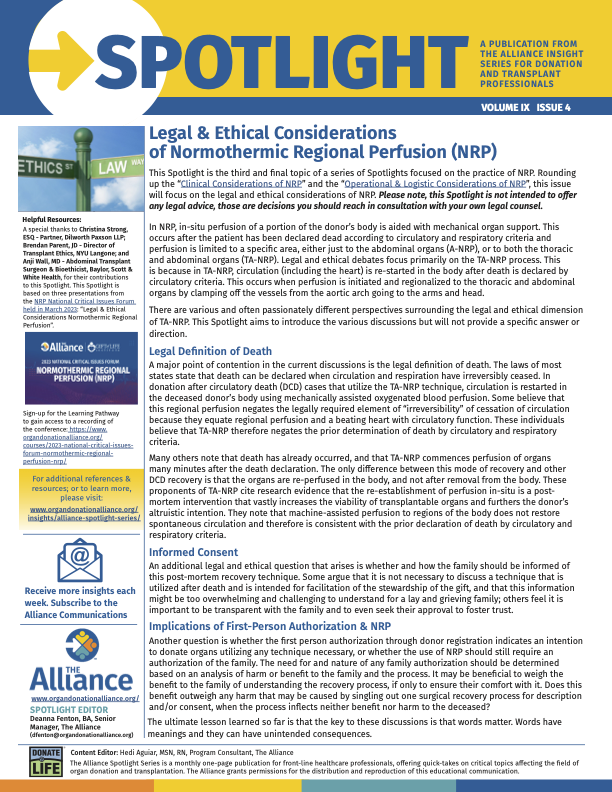This Spotlight is the third and final topic of a series of Spotlights focused on the practice of NRP. Rounding up the “Clinical Considerations of NRP” and the “Operational & Logistic Considerations of NRP”, this issue will focus on the legal and ethical considerations of NRP.
In NRP, in-situ perfusion of a portion of the donor’s body is aided with mechanical organ support. This occurs after the patient has been declared dead according to circulatory and respiratory criteria and perfusion is limited to a specific area, either just to the abdominal organs (A-NRP), or to both the thoracic and abdominal organs (TA-NRP). Legal and ethical debates focus primarily on the TA-NRP process. This is because in TA-NRP, circulation (including the heart) is re-started in the body after death is declared by circulatory criteria. This occurs when perfusion is initiated and regionalized to the thoracic and abdominal organs by clamping off the vessels from the aortic arch going to the arms and head.
There are various and often passionately different perspectives surrounding the legal and ethical dimension of TA-NRP. This Spotlight aims to introduce the various discussions but will not provide any specific answers or directions.
A major point of contention in the current discussions is the legal definition of death. The laws of most states state that death can be declared when circulation and respiration have irreversibly ceased. In donation after circulatory death (DCD) cases that utilize the TA-NRP technique, circulation is restarted in the deceased donor’s body using mechanically assisted oxygenated blood perfusion. Some believe that this regional perfusion negates the legally required element of “irreversibility” of cessation of circulation because they equate regional perfusion and a beating heart with circulatory function. These individuals believe that TA-NRP therefore negates the prior determination of death by circulatory and respiratory criteria.
Many others note that death has already occurred, and that TA-NRP commences perfusion of organs many minutes after the death declaration. The only difference between this mode of recovery and other DCD recovery is that the organs are re-perfused in the body, and not after removal from the body. These proponents of TA-NRP cite research evidence that the re-establishment of perfusion in-situ is a post-mortem intervention that vastly increases the viability of transplantable organs and furthers the donor’s altruistic intention. They note that machine-assisted perfusion to regions of the body does not restore spontaneous circulation and therefore is consistent with the prior declaration of death by circulatory and respiratory criteria.
An additional legal and ethical question that arises is whether and how the family should be informed of this post-mortem recovery technique. Some argue that it is not necessary to discuss a technique that is utilized after death and is intended for facilitation of the stewardship of the gift, and that this information might be too overwhelming and challenging to understand for a lay and grieving family; others feel it is important to be transparent with the family and to even seek their approval to foster trust.
Another question is whether the first person authorization through donor registration indicates an intention to donate organs utilizing any technique necessary, or whether the use of NRP should still require an authorization of the family. The need for and nature of any family authorization should be determined based on an analysis of harm or benefit to the family and the process. It may be beneficial to weigh the benefit to the family of understanding the recovery process, if only to ensure their comfort with it. Does this benefit outweigh any harm that may be caused by singling out one surgical recovery process for description and/or consent, when the process inflects neither benefit nor harm to the deceased?
~ The ultimate lesson learned so far is that the key to these discussions is that words matter.
Words have meanings and they can have unintended consequences. ~
Note: This Spotlight is not intended to offer any legal advice, those are decisions you should reach in consultation with your own legal counsel.







